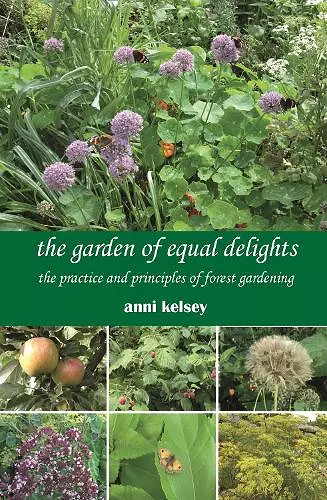the garden of equal delights
the practice and principles of forest gardening
Format:Paperback
Publisher:Triarchy Press
Published:22nd Jun '20
Should be back in stock very soon

Forest gardens are much in the news as an exemplary form of resilient, sustainable, small-scale agriculture and plenty has been written about them already. But little has been written about the role of those who 'look after' them. A forest garden is edible, fertile, abundant and beautiful because it functions as an ecosystem. The forest gardener is an integral part of this ecosystem - which raises the question of what exactly the forest gardener should be trying to do. This book answers that question. At the heart of a forest garden is the unique relationship between the garden and the gardener. The 'garden of equal delights' after which this book is named is Anni Kelsey's forest garden high on a wet and windy Welsh hillside. Rejecting control and a regimen of planned interventions in favour of a more intimate, knowing and connected relationship with her garden, Anni describes how she learned to garden as an intrinsic - and equal - part of the ecosystem. She uses her years of experience to formulate and explain in very practical terms a set of principles that other forest gardeners can follow in their own preferred way. So this is a challenging and inspiring story for experienced, new and would-be forest gardeners and for anyone with a love of nature and a longing to engage with it on a deeper level. A forest garden is a different garden which needs to be gardened differently by a different gardener.
This is a book about how to be a forest gardener. It is not a 'how to' garden book. The emphasis is on being and becoming, rather than doing. Anni shows us that forest gardening is a different type of gardening from the horticultural norm; one which requires a different type of gardener. Her book shows how the garden and gardener can grow together in a process of co-creativity in which an abundant ecosystem emerges. The job of the forest gardener, suggests Anni, is largely one of learning to keep out of the way; to sit on ones hands. To watch, and wait, and learn from the garden about how it wants to grow. The gardener may then make gentle, informed interventions - a nudge here, a suggestion there - without being wedded to the outcome. But this isn't necessarily as easy as it sounds; it takes practice. By telling the story of her own garden, Anni shows us how she developed this practice. The work of the forest gardener, she suggests, shifts from traditional tasks of digging and weeding, to more observational 'tasks' of watching, waiting, and learning how the garden develops as an ecosystem. She acknowledges that watching and waiting can be uncomfortable, as the gardener gives up their enculturated urges to tidy or weed and lets the garden run rampant. The gardener allows this to happen. Their job is to watch carefully as an ecosystem slowly develops that no longer requires pest management, weeding, or added fertility. Only once the forest gardener begins to understand this ecosystem, and the many interactions occurring within it, can they begin to gently intervene.
ISBN: 9781911193746
Dimensions: unknown
Weight: unknown
198 pages